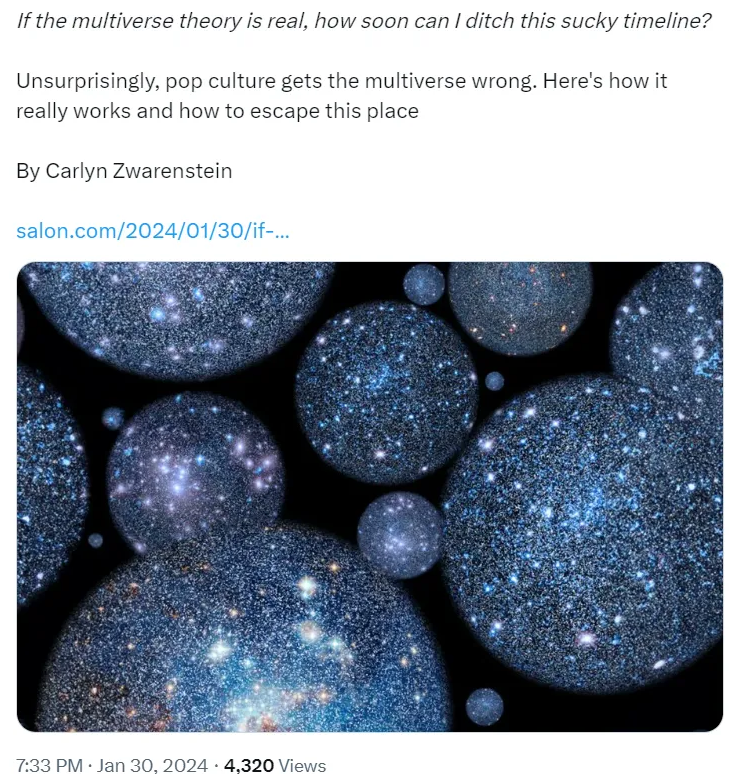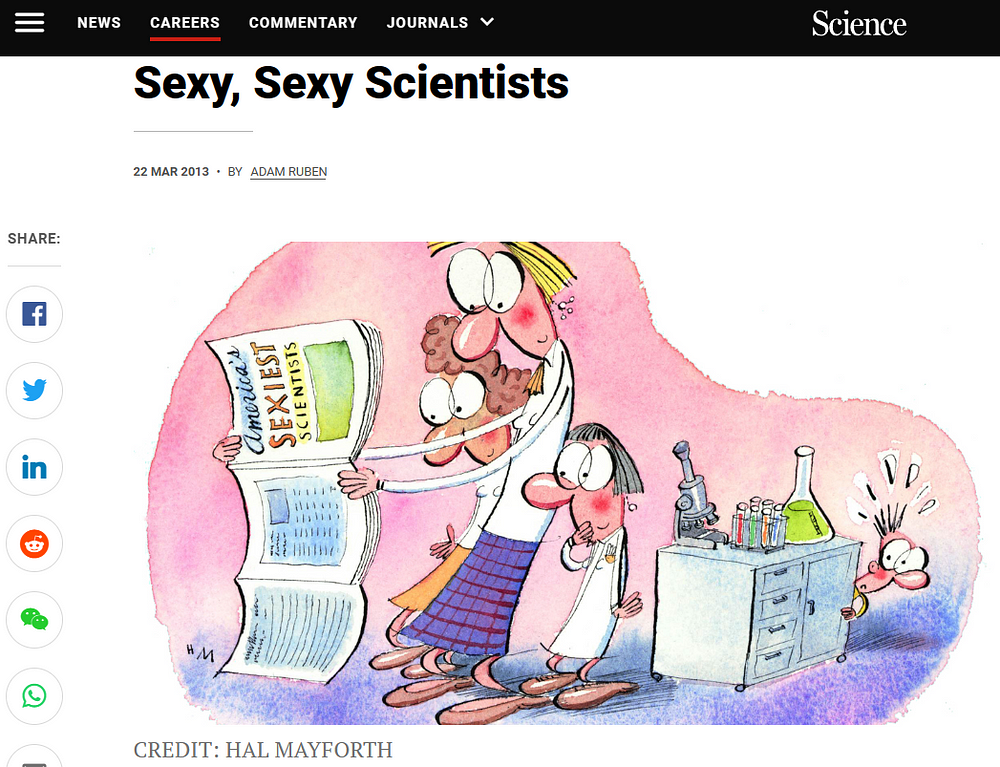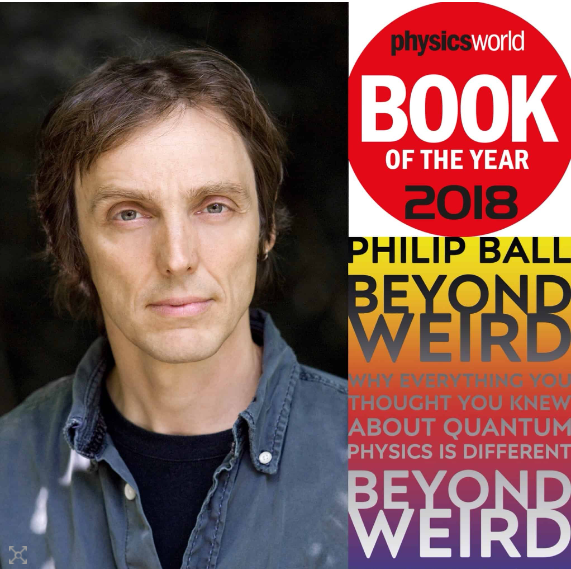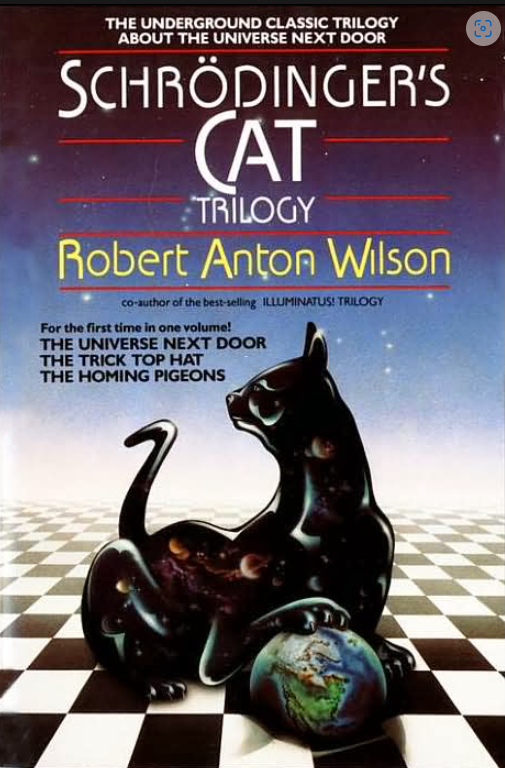
“Unsurprisingly, pop culture gets the multiverse wrong.”

Pop culture often gets these things wrong partly — or even largely — because of what physicists themselves write and say. More accurately, it gets things wrong because of what physicists write in their “popular science” books.
So perhaps this is what Carlyn Zwarenstein means by “pop culture” — stuff that includes books and articles written by professional scientists. (She mentions the science writer and physics professor Paul Halpern later.)
In the case of the tweet above, why is there an assumption here that pop culture is getting things wrong when it comes to (what she calls) “multiverse theory”? After all, lots of theoretical physicists, physicists generally, philosophers, etc. have a serious problem with this theory too. They also disagree a lot on this subject.
The other thing about this tweet is that it also assumes that there’s a single pop-culture view of the multiverse.
So perhaps all this boils down to the vagueness (or inaccuracy) of that very term — “pop culture”.
All this has also got a lot to do with scientists (i.e., not pop culture!) attempting to make their scientific specialisms and interests sexy.
There are two main reasons why such scientists tart up (their?) science:
(1) In order to get more people interested in science.
(2) To help sell more of their own books.
Of course, there’s nothing wrong with simplifying science for a general audience. (I myself rely on such simplifications.) However, there is something wrong with attempting to make things sexier than they actually are. More importantly, there is a problem if the sexed-up science is actually misleading — or even downright false!
Take the case of the multiverse, as referred to in Carlyn Zwarenstein’s tweet.
The Sexy Multiverse

Firstly, I’m aware that many-worlds theory and ideas about a multiverse are very different. (There are even many different accounts of the multiverse, what it is, and how it came about. See note 1.) However, the existence of many worlds and the multiverse are both deemed to be equally sexy.
I’m also more than willing to accept that it’s possible that there are many worlds, or that there’s a multiverse. I’m even willing to accept that many worlds actually exist. However, I’m not willing to accept the titillating, sexy and self-obsessive crap that’s said about them by… scientists.

The science writer Philip Ball tells us why many people find many-worlds theory (or, more accurately, the many-worlds interpretation) appealing. He writes:
“Alternative realities hold an irresistible allure. Whether it’s Dickens’ A Christmas Carol, Frank Capra’s It’s a Wonderful Life, or the quantum-computed parallel universes of Alex Garland’s recent TV series Devs, the possible lives that we can imagine having led but did not lead offer a stage for acting out our fears and fantasies.”
Ball then ties all that to the science… or, more precisely, to the interpretations of the science. He continues:
“It is no surprise, then, that the Many Worlds interpretation (MWI) of quantum mechanics seems to hold such attraction. Even though most physicists dismiss or even deride it, it is often eagerly embraced by physics popularizers and their audiences. Yet it can be hard to figure out how seriously some of its advocates really take it. I believe some physicists genuinely see it as an elegant solution to deep conundrums of the notoriously mind-bending quantum theory, and I sympathize with some of their reasoning. But when they start talking about ‘quantum brothers’ (and presumably sisters, though Many Worlds has curiously few female advocates) [] I have to wonder whether, indifferent to the philosophical complications, they are just enjoying the fantasy.”
Note the words “[j]ust enjoying the fantasy”.
And what’s wrong with that?
Nothing... at least outside of any context.
As long as we all realise that’s precisely what it is: people just enjoying the fantasy.
What’s more, it’s not as if Philip Ball has just made all this stuff up either. For example, according to the science writer John Gribbin, “[t]here really is [] a Wuthering Heights world (but not a Harry Potter world)”.
Interestingly enough, Carlyn Zwarenstein (i.e., the author of the opening tweet above) also touches on this issue in the following passage:
“‘Forward time travel is possible if you can approach the speed of light,’ says Paul Halpern [], a physics professor and prolific science writer whose book about the concept of the multiverse, The Allure of the Multiverse: Extra Dimensions, Other Worlds, and Parallel Universes, was just published.
“Yesssss! That’s more like it.
“But as usual, science is out to burst this writer’s bubble. As it turns out, you can’t approach the speed of light. (Well, not with that attitude).”
Readers will have noted the words “The Allure of the Multiverse”!
If we return to Philip Ball. He’s not alone on this “postmodern science” bonanza. Take the following critical views of the multiverse theory… and string theory.
Firstly, here’s the science journalist John Horgan:
“[S]cience that is not experimentally testable or resolvable even in principle and therefore is not science in the strict sense at all. Its primary function is to keep us awestruck before the mystery of the cosmos.”
And now for Jim Holt:
“For the first time in its history, theory has caught up with experiment. In the absence of new data, physicists must steer by something other than hard empirical evidence in their quest for a final theory.”
Perhaps Horgan and Holt are themselves part of the “pop culture” referred to in the opening tweet. That said, I’ve already made the point that there are plenty of professional physicists who’re critical of the multiverse, many worlds, etc.
Now Take the word “weird”, which is relentlessly used when it comes to quantum mechanics.
Sexy and Weird Quantum Mechanics

As a starter, click the words “Quantum mechanics is weird” as they’re fed into Google search. You’ll get hundreds — possibly thousands — of entries and links which take you to films, books, articles, papers and documentaries.
Here again, it’s often physicists themselves who stress the “weirdness” of quantum mechanics, not pop culture. And I suspect that many physicists do so in order to entice laypersons into (their?) physics.
In any case, I have backup here.
In 2018, the science writer Philip Ball had a book published called Beyond Weird: Why Everything You Thought You Knew About Quantum Mechanics is Different. In that book he downplays the “weirdness” of quantum mechanics, at the same time as he stresses new approaches to its interpretation.
The physicist Christopher Fuchs (as quoted by Ball) also expresses the problem with quantum mechanics in terms of “all the posturing and grimacing over [its] paradoxes and mysteries”. In other words, for many laypersons and popular-science writers especially, that posturing and grimacing seems to have become the very essence of quantum mechanics.
Philip Ball also cites Richard Feynman’s often-quoted words:
“I think I can safely say that no one understands quantum mechanics.”
Thus, from the line “quantum mechanics is weird”, there follows the no-one-understands-quantum-mechanics mantra.
Ball picks up on the bizarre nature of Feynman’s statement when he says that
“[a]t that point, no one alive knew more than Richard Feynman about quantum mechanics”.
He concludes: “What hope is there, then, for the rest of us?”
To be honest, I find Feynman’s remark rhetorical, as I suspect Ball does too. After all, it’s fairly well-known that Feynman didn’t have too much time for the interpretations of quantum mechanics, let alone for the philosophy of quantum mechanics. In other words, Feynman knew all (or at least most) of the relevant mathematics. “The trouble was”, as Ball puts it, “that’s all he could do.”
Philip Ball then applies more or less the same arguments found above to the specific and well-known case of Schrödinger’s cat.
Schrödinger’s Sexy Cat

First of all, Philip Ball tells us that
“in neither the Copenhagen nor the Many Worlds interpretation is the cat ‘simultaneously alive and dead’”.
In more detail, Ball also writes:
“I think Bohr might have said something along the lines that ‘Observation allows us to speak about the classical state of the cat. And look, it is a dead one!’.”
In other words, until we get information about the cat, we don’t know if it’s alive or dead. It’s not the case that it’s both alive and dead at one and the same time (i.e., before we gain that information). However, until we get that information, the cat may as well be both alive and dead…
But only in a manner of speaking!
Ball then offers up a more original take on this sexy-cat scenario.
Basically, why the hell are we talking about an alive and dead cat in the first place?
Sure, this was meant to be a colourful thought-experiment (i.e., against a certain take on quantum mechanics). However, it’s a thought-experiment which many people don’t actually take to be a thought-experiment at all. In Ball’s own words:
“In order to be able to talk about the [cat] scenario in quantum terms, we need to be able to express it in quantum terms. But we can’t, because ‘live cat’ and ‘dead cat’ are not well-defined quantum states.”
I don’t know about “well-defined quantum states”: a live cat and a dead cat (both together or separately) don’t seem to be quantum states at all. Perhaps that doesn’t matter. After all, what’s happening here is that we’re applying a quantum-mechanical situation (or possibility) to the “real world” — to a cat!
One problem here is thinking of quantum particles as classical particles which nonetheless behave in very non-classical ways. (Alternatively, the problem is thinking of quantum particles as being what Michael Brooks calls “objects” in the first place.) Many of the examples of quantum “weirdness” stem from that situation — at least those weird things which belong to the many and various interpretations of quantum mechanics. Yet whatever it is that quantum physicists deal with, it isn’t equivalent to classical objects. It’s not even equivalent — or similar — to particles of dust, sand or glass. [Here’s Carlo Rovelli playing down quantum weirdness.]
Thus, why should it be weird that a quantum x doesn’t behave like a classical object or even a classical particle? In reverse, if a classical object were to behave like a quantum x, then that would be weird…
So many people believe that quantum phenomena are weird mainly because they see them as being classical phenomena which nonetheless behave in very non-classical ways. Yet, in actual fact, we only have quantum phenomena behaving in quantum ways — just as classical phenomena behave in classical ways.
Of course, now there’s the problem of the Heisenberg cut. There’s also much dispute as to whether there is such a neat and tidy (to use the words of the physicist and science writer Brian Greene)“line in the sand” between the quantum realm and the classical realm.
But that’s another subject entirely…
Note:
(1) Talking about “pop culture”…
In Christopher Nolan’s film Tenet, the character Neil mentions “parallel worlds”. So it’s worth making a distinction here between other dimensions, parallel worlds, and Hugh Everett’s many worlds.
Other dimensions are dimensions of our universe. (This is a fundamental part of string theory.) Parallel worlds, on the other hand, may be completely separate from our world.
So can there be “causal contact” between parallel worlds and our world?
This must surely mean that the only possibility that Tenet can have in mind is parallel dimensions, not parallel worlds. Indeed, when it comes to parallel worlds, it’s hard to make sense of the word “parallel” at all. These worlds simply can’t be parallel to our world.
So perhaps no one is expected to take the word “parallel” literally.
And just as a distinction has just been made between parallel dimensions and parallel worlds, so a distinction can also be made between the many worlds (i.e., of many-worlds theory) and the other “universes” of a multiverse. In the many-worlds interpretation, the possibility of causal — or other kinds of — contact between our world and other worlds is accepted — at least by some scientists. [See also brane cosmology.] However, when it comes to our universe and another universe (or a “bubble universe”) in a multiverse, that isn’t usually accepted by scientists. (Although there is some talk of “colliding” universes, etc.)









No comments:
Post a Comment